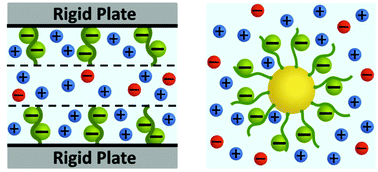Polyelectrolyte brushes: theory, modelling, synthesis and applications
Abstract
Polyelectrolyte (PE) brushes are a special class of polymer brushes (PBs) containing charges. Polymer chains attain “brush”-like configuration when they are grafted or get localized at an interface (solid–fluid or liquid–fluid) with sufficiently close proximity between two-adjacent grafted polymer chains – such a proximity triggers a particular nature of interaction between the adjacent polymer molecules forcing them to stretch orthogonally to the grafting interface, instead of random-coil arrangement. In this review, we discuss the theory, synthesis, and applications of PE brushes. The theoretical discussion starts with the standard scaling concepts for polymer and PE brushes; following that, we shed light on the state of the art in continuum modelling approaches for polymer and PE brushes directed towards analysis beyond the scaling calculations. A special emphasis is laid in pinpointing the cases for which the PE electrostatic effects can be de-coupled from the PE entropic and excluded volume effects; such de-coupling is necessary to appropriately probe the complicated electrostatic effects arising from pH-dependent charging of the PE brushes and the use of these effects for driving liquid and ion transport at the interfaces covered with PE brushes. We also discuss the atomistic simulation approaches for polymer and PE brushes. Next we provide a detailed review of the existing approaches for the synthesis of polymer and PE brushes on interfaces, nanoparticles, and nanochannels, including mixed brushes and patterned brushes. Finally, we discuss some of the possible applications and future developments of polymer and PE brushes grafted on a variety of interfaces.


 Please wait while we load your content...
Please wait while we load your content...